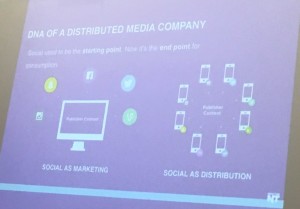Many companies like Facebook and Snapchat are asking the media to forgo their websites and and publish directly to their platforms. Each of the panelist briefly talked about their companies and some of the opportunities and challenges of distributed content.
 Kim Bui, Deputy Managing Editor at reported.ly, talks about where the team is dispersed throughout the world. “We are a little over a year old, and we are a distributed team. We have 3 in Europe, some in Ireland, Italy, Greece, and the United States. In our core values, we said what we’re going to do and what we aren’t going to do. We understand we have a little bias and we’re going to be honest about it because we are humans. We take social media and elevate voices and shine a light on stories,” Bui said.
Kim Bui, Deputy Managing Editor at reported.ly, talks about where the team is dispersed throughout the world. “We are a little over a year old, and we are a distributed team. We have 3 in Europe, some in Ireland, Italy, Greece, and the United States. In our core values, we said what we’re going to do and what we aren’t going to do. We understand we have a little bias and we’re going to be honest about it because we are humans. We take social media and elevate voices and shine a light on stories,” Bui said.
Versha Sharma, Managing Editor at NowThis Media, explains how their main reporting is via videos and gifs. “We distribute videos and gifs across 16 different platforms. NowThis has recently joined Snapchat Discover. We distribute in other languages and countries. We have an app and you can see videos on mobile web because today the news lives where you live, and that is on social,” Sharma said.
Since we are on mobile devices all the time, Ashley Codianni, Global Director of Social Publishing for CNN, says that they curate and create content to be optimized for the mobile audience within the digital space.
 NowThis has 6 million followers across their social media channels. The biggest, of course, being Facebook. On Facebook video has exploded in the last year. While two years ago, NowThis was publishing native video to Facebook. On Facebook, they have almost 600 million monthly views. “We have an audience that is very engaged in marijuana policy, so we have NowThis Weed on Facebook, and it’s actually popular,” Sharma said. “We found that our audience is young. 70% of them are under the age of 34. There’s a stereotype that millennials aren’t interested in news, but if you deliver it to where they always are, they will engage in it.”
NowThis has 6 million followers across their social media channels. The biggest, of course, being Facebook. On Facebook video has exploded in the last year. While two years ago, NowThis was publishing native video to Facebook. On Facebook, they have almost 600 million monthly views. “We have an audience that is very engaged in marijuana policy, so we have NowThis Weed on Facebook, and it’s actually popular,” Sharma said. “We found that our audience is young. 70% of them are under the age of 34. There’s a stereotype that millennials aren’t interested in news, but if you deliver it to where they always are, they will engage in it.”
Bui comments on the best thing about their team is that they are cross cultural. “That gets us ahead of stuff that we have people around the world. They have different backgrounds, about half female and half male. We are very diverse. On top of that, we all have different backgrounds. My boss is a blogger, I have a strict news background, our managing editor is huge on verification, we have someone who live tweets, and then we have people with a radio and TV background. That is important and we wouldn’t be able to do those things without having different backgrounds,” Bui said.
Codianni mentions the importance of optimizing video content on social platforms. Since most of the audience is on mobile, they produce video content that is text on screen and cut it in a format that is optimized for mobile.
Justin Ellis, SR Editor at ESPN Magazine asked Sharma how their company makes money. “Branded content,” Sharma said. “We had sponsored content this week from GE, and our labels will say sponsored. The branded content is the primary way we make money.”
When Codianni was asked the same question, she responded that they monetize when the time is right. “We create millions of pieces of content regularly. Facebook Instant Articles and suggested videos staying on that platform is something we’re doing. We want to build audiences where they are, and then monetize when it’s the right time. There is value in being at places early and developing audiences early. I think it’s great for us to be working with media companies, it’s shared opportunity and value,” Codianna said.
There are, however, challenges with distributed content. Sharma explains how the biggest challenge is that many platforms don’t have the data or insights for publishers to work with. “Snapchat is the biggest one that doesn’t share data. Facebook however, is more developed in terms of analytics. We can see the demographics, the views, but also go into a video and see where the viewers stopped watching. We count comments and shares on video. Facebook is just eager to work with news publishers an they provide us with this data. But others don’t provide analytics that are as thorough,” Sharma said.
Ellis ended with asking the panelists which platform we should be paying attention to next. Messaging apps.
I asked Justin Ellis what he thinks the opportunities are with distributed content.
